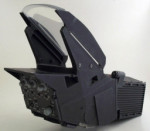In January 1972 the Lightweight Fighter Programme asked for designs from several American manufacturers. In January 1975 General Dynamics was pronounced the winner with the YF-16. Since its small beginning with an initial USAF order for 650 aircraft, the F-16 has become one of the largest and most successful military aircraft in aviation history. At least 23 countries have purchased the F-16 in various forms.
The HUD system, which at one point seems to have been called the HUDSIGHT by the Company, consisted of a Pilot’s Display Unit (PDU), an Electronics Unit (EU) and a Rate Sensor Unit (RSU). General Dynamics however called it the Fire Control Sight System FCSS.
The F-16 A/B was an international programme with a requirement for offset. The HUD PDU and EU were both built in Rochester and at Atlanta in Georgia, de Oude Delft in the Netherlands also built the PDU and Kongsberg Vapenfabrik in Norway also built the EU. The Rochester site was responsible for the design, production and supply of complete HUD systems. The legend "27489" on the Ident labels of many of the boxes is a defunct CAGE code for the Rochester site of Elliott Bros (London) Ltd.
The PDU has four functional groups, the cathode ray tube assembly (CRT), the optical module, the chassis and the control panel. The CRT assembly comprises the tube itself, the deflection coils and a matching circuit to compensate for minor variations in individual CRT’s. The CRT was made by Rank Brimar and it was this system that initially used the Muirhead deflection coils.
The Total Field of View of the F-16 A/B PDU is 20deg but the Instantaneous FoV is only 9deg in elevation and 13.38deg in azimuth because the combiner to eye distance is quite large due to the highly angled seat. The whole optical system has to correct for display distortions and try to correct for canopy distortions. The F 16 bubble canopy is particularly difficult and every canopy is different needing unique correction. The lens system is a standard Petzval design but it includes a prism block used to inject a red Standby Sight. The Sight is depressible from a PDU Control Panel and has a Night Blind to reduce the intensity of the display at night. At this time it was not possible to get a very low and stable luminance on the CRT; there was always the danger that it might disappear altogether so the Night Blind allowed the tube to be run at a higher and stable luminance. The housing for the Standby Sight lamp gives a prominent finned bulge under the aft end of the PDU.
The PDU has a very rigid Combiner frame to withstand birdstrike on the F 16 where the canopy can deform onto the HUD and it is even possible for a bird to penetrate the canopy. These PDU’s are unique in being designed and tested to withstand both windblast if the canopy is lost and birdstrike.
The F-16 Electronics Unit was based on a powerful general purpose computer using MSI TTL technology. It contains a MIL-STD-1553 data bus interface, processor and symbol generator. Data can be received in analogue form but the digital Databus significantly reduces the number of data lines. With progressively smaller airframes finding space for the traditional bundles of analogue cables and their bulky connectors was becoming a problem so the new system links HUD, attack radar, fire control computer and the inertial navigation system all through the 1553 data-bus. Development of small RISC processors had continued within ADD and FARL and the F-16A/B emerged with a solid state 16K 16-bit store in what was basically a 12/16 RISC implementation. Eventually the memory was increased to 32k.






